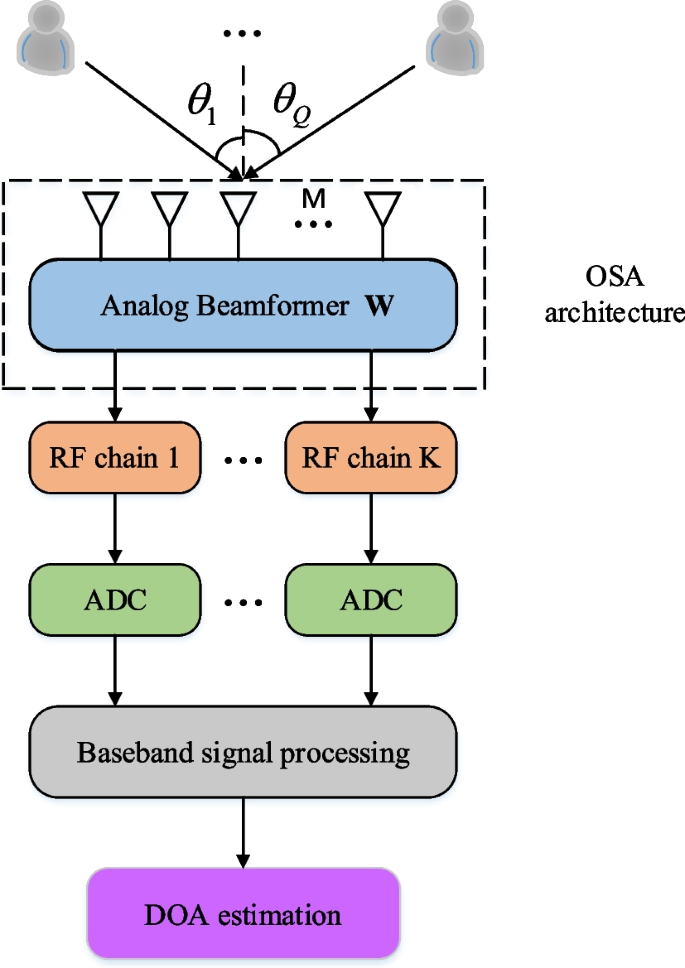Deep learning-based DOA estimation for hybrid massive MIMO receive array with overlapped subarrays
IF 1.9
4区 工程技术
Q3 ENGINEERING, ELECTRICAL & ELECTRONIC
Eurasip Journal on Advances in Signal Processing
Pub Date : 2023-10-30
DOI:10.1186/s13634-023-01074-3
引用次数: 0
Abstract
Abstract As massive MIMO is a key technology in the future sixth generation (6G), the large-scale antenna arrays are widely considered in direction-of-arrival (DOA) estimation for they can provide larger aperture and higher estimation resolution. However, the conventional fully digital architecture requires one radio-frequency (RF) chain per antenna, and this is challenging for the high hardware costs and much more power consumption caused by the large number of RF chains. Therefore, an overlapped subarray (OSA) architecture-based hybrid massive MIMO array is proposed to reduce the hardware costs, and it can also have better DOA estimation accuracy compared to non-overlapped subarray (NOSA) architecture. The simulation results also show that the accuracy of the proposed OSA architecture has $$6^{\circ }$$

基于深度学习的重叠子阵混合海量MIMO接收阵列DOA估计
大规模MIMO是未来第六代(6G)通信的关键技术之一,大规模天线阵列由于能够提供更大的孔径和更高的估计分辨率,在到达方向(DOA)估计中得到了广泛的考虑。然而,传统的全数字架构需要每个天线一个射频(RF)链,这对于高硬件成本和大量射频链造成的更多功耗来说是具有挑战性的。为此,提出了一种基于重叠子阵列(OSA)架构的混合大规模MIMO阵列,在降低硬件成本的同时,相对于非重叠子阵列(NOSA)架构具有更好的DOA估计精度。仿真结果还表明,所提出的OSA结构的精度比信噪比为10 dB的NOSA结构有$$6^{\circ }$$ 6°的优势。此外,为了提高DOA估计分辨率,将卷积降噪自编码器(CDAE)与深度神经网络(DNN)相结合,提出了一种基于深度学习的DOA估计器,CDAE可以去除样本协方差矩阵(SCM)的近似误差,DNN可以进行高分辨率DOA估计。从仿真结果来看,CDAE-DNN在$$\textrm{SNR}=-8$$信噪比= - 8 dB,快照个数$$N=100$$ N = 100时可以达到精度下界,这意味着CDAE-DNN在通信较差的情况下具有更好的性能,并且与传统估计器相比可以节省更多的软件资源。
本文章由计算机程序翻译,如有差异,请以英文原文为准。
求助全文
约1分钟内获得全文
求助全文
来源期刊

Eurasip Journal on Advances in Signal Processing
ENGINEERING, ELECTRICAL & ELECTRONIC-
CiteScore
3.40
自引率
10.50%
发文量
109
审稿时长
3-8 weeks
期刊介绍:
The aim of the EURASIP Journal on Advances in Signal Processing is to highlight the theoretical and practical aspects of signal processing in new and emerging technologies. The journal is directed as much at the practicing engineer as at the academic researcher. Authors of articles with novel contributions to the theory and/or practice of signal processing are welcome to submit their articles for consideration.
 求助内容:
求助内容: 应助结果提醒方式:
应助结果提醒方式:


